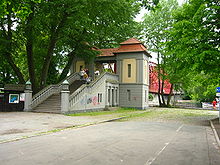Tegel harbor bridge
Coordinates: 52 ° 35 ′ 24 ″ N , 13 ° 16 ′ 16 ″ E
| Tegel harbor bridge | ||
|---|---|---|
| View of the Tegel harbor bridge | ||
| use | Foot traffic | |
| Subjugated | Tegeler Fliess | |
| place | Berlin Tegel | |
| overall length | 91 m | |
| construction time | 1908-1909 | |
| location | ||
|
|
||
The Tegeler Hafenbrücke ( ) in the Berlin district of Tegel , popularly known as the "Sechserbrücke", spans the entrance of the Tegeler Hafen and the mouth of the Tegeler River as a pedestrian bridge . It was built in 1908 as a steel truss arch bridge including a concrete part over the Tegeler Fließ with a total length of 91 meters together with the port and the Tegel-Friedrichsfeld industrial railway; The southern gateway with two ticket booths did not follow until 1921 - architect: city architect Ernst Hornig. Today it is a listed building and is often the setting for filming .
prehistory
At the end of the 19th century there was a lot of excursion traffic on the north bank of the Tegeler See : people strolled along the Uferstraße (today's Greenwich Promenade ) around the Großer Malchsee to the Tegelsee open-air swimming pool. To do this, however, they had to cross the Tegeler Fliess. The local fisherman Siebert earned extra income by crossing the hikers across the river in his boat for five pfennigs (a so-called " six ").
At the turn of the century, the number of excursions continued to grow and more and more Berliners wanted to go to the Großer Malchsee, where numerous places for excursions had established themselves in the meantime, such as the Klippsteinsche Sommeretablissement and the Kaiserpavillon . The fisherman could no longer cope with the increased volume with his boat and so he built a small wooden bridge over the river and continued to demand five pfennigs from anyone who wanted to cross it. The Siebert'sche Brücke had to give way to the expansion of the Tegeler Hafen in 1905.
The owner of Schloss Tegel, Constanze von Heinz, began to parcel out land in the castle district from around 1870 and sell it for the construction of villas or self-built villas. After the turn of the century, she had the large imperial pavilion, aimed at wealthy customers, and the equally extensive and sophisticated “Kurhaus” built. The second entrance to the castle district (next to Schlossstrasse) was important for pedestrians. The community of Tegel and Ms. von Heinz therefore contributed equally to the financing and maintenance of the bridge.
Building history and today's shape of the "Sechserbrücke"
The construction work was carried out by the Berlin construction company Steffens & Nölle . The main passage of the bridge has a span of 65 meters.
The new operators of the bridge kept the "Sechser" as a bridge toll and the public on the name "Sechserbrücke". Since Tegel was not incorporated into Berlin (Greater Berlin) until 1920, the Tegeler Sechserbrücke was not one of the four classic Berlin Sechserbrücken . The two investors were left with a net profit of 7,000 marks almost every year . However, inflation in Germany put an end to the " bridge tariff " in 1922, as personnel costs exceeded income.
The "Sechserbrücke" was built by the steel construction company Steffens & Nölle AG, founded in 1893. The new bridge had to have a significantly greater clearance so that the barges could pass the port entrance. This makes the Tegeler Hafenbrücke an imposing structure for pedestrian bridges. It consists of two parts: The actual steel truss bridge (today painted red) only spans the harbor entrance to the foundation, including two pavilion-like structures on the western tip of today's Humboldt Island . Another bridge part made of concrete (in gray color) spans the mouth of the Tegeler River up to the bridgehead including the staircase. The two pavilion-like structures on the north side are provided with an accessible, narrow circumferential gallery. The Humboldt Island can be reached via a staircase in the eastern "pavilion" that is not accessible to the public.
environment
From the bridge you have a good view of the Tegeler Hafen and the inconspicuous Tegeler Fließ, which runs parallel to the harbor, separated from the elongated Humboldt Island. In the other direction towards Lake Tegel you can see the Hasselwerder island on the left and the Reiherwerder peninsula on the right . In between in the background you can see as far as the Tegelsee outdoor pool . A few minutes' walk away is the " Dicke Marie ", probably the oldest tree in Berlin.
literature
- Hainer Weißpflug: The "Six Bridge" in Tegel . In: Berlin monthly magazine ( Luisenstädtischer Bildungsverein ) . Issue 11, 1997, ISSN 0944-5560 , p. 63-65 ( luise-berlin.de ).
- Senator for Building and Housing (Ed.): Pedestrian bridges in Berlin . Berlin 1976, p. 22nd f .
Web links
- Entry in the Berlin State Monument List
- Tegel harbor bridge. In: Structurae
- Relief at the Sechserbrücke at Tegeler Hafen . At: berlin-magazin
- The six bridge. in-berlin-brandenburg.com
Remarks
- ^ From the mid-1970s: Turmbau Steffens & Nölle. With the radio tower, the company built a major Berlin attraction in 1926.




